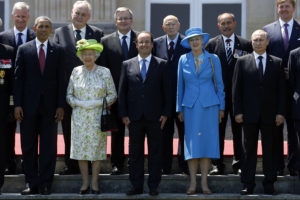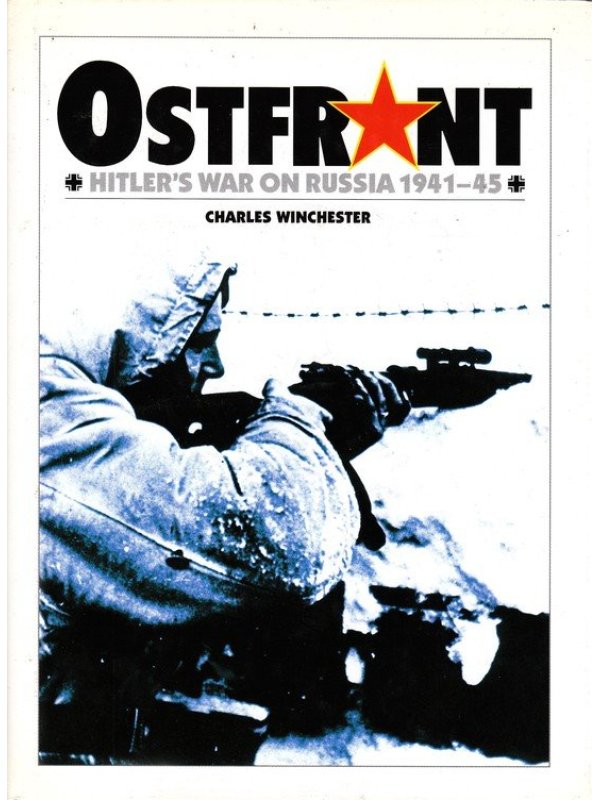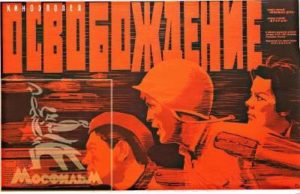All Clickable Links in red
May 8 is an important date for Europeans. On this day in 1945, the European part of WW2 ended. VE day as it is known to the Western Allies, is celebrated in various ways. In Russia , it is celebrated as Victory Day with a huge military parade that sometimes included equipment from WW2. The Russians called their part of the war from June 1941-May 1945 as The Great Patriotic War (and there is lots of justification for that title)
On June 6,2014 all the leaders of the Western World attended the 70th anniversary of the Western Allied landings in Normandy, in 1944. Vladimir Putin also attended as the Soviet Union also had been their ally from 1941-45 (see below pic).

However on May 8, 2015 , the 70th anniversary of the end of WW2 in Europe, the story was different . None of the Western leaders who had been invited for the Victory Day parade were present.. The calculated insult by the Western leaders was obvious. Only President Xi from China, President Pranab Mukherjee from India and other “third world” and “CIS” leaders were present in strength.
Thanks to the “Old” Cold War and the “New” Cold War, the Russians remain “enemies” of the West and this is reflected in the production of War movies. Despite being the largest producer of war films, Hollywood has yet to produce a notable movie about the Eastern Front of WW2, where the Soviets suffered heavy losses and the Germans faced a crushing defeat.
Here is the wikipedia page on World War 2 civil and military casualties. The graph from the page is reproduced below

Any which way one looks at it , the Soviet casualties are appalling. 22 million Soviets died of which only 8 million were soldiers while the rest were all civilians. This was a result of the German attitude towards the Soviet land, which they believed to be filled with “untermenschen” – sub humans – who are only fit for slave labor or mass extermination, combined with a “damn the casualties” Soviet attitude.
In my view, there are five broad phases to the entire Eastern Front War . (its a lot more complex as simultaneously many operations were ongoing across the 3000+ km front stretching from the Baltic Sea to the Black Sea)
- June 1941 – December 1941 – Hitler’s Armed Forces steamroller the Soviet Armed Forces and are within a few kilometres of Moscow but they ran out of steam and the brutal Russian winter halts the German War machine. The Soviets chose this moment to push back the Germans who had to abandon territories captured in the lightning offensives. (Legend has it that a German recce unit saw the Kremlin spires from the Moscow outskirts).
- January 1942 – February 1943 – the Stalingrad phase – the revived Germans now went on the offensive but the Soviets smartly used the same German tactics (instead of fighting to the last man as in the earlier days) of pulling back and / or absorbing the blows , trading space for time . Recognizing the symbolic importance, Hitler and Stalin invested considerable resources and troops in capturing a city bearing Stalin’s name. The Russian offensive in November 1942 found the Germans encircled and by February 1943 , 90,000 starving Germans had no choice but to surrender.
- February 1943 – July 1943 – the Kursk Phase. Operation Citadel, codename for the Kursk battle,is acknowledged to be the largest tank battle ever in the history of warfare with about 7 – 8000 German and Soviet tanks slugging it out . The Germans had numerical and technical superiority but they faced layered defences in depth , upto 10 kilometers. (Even Hitler confessed that Operation Citadel made his stomach turn). Once their offensive ran out of steam , the Soviets counter attacked and even the German technical superiority was of no use.
- August 1943 – January 1945 – Liberation of Eastern Europe. Most of the countries that later became part of the Warsaw Pact that were under German rule , were steadily liberated by the Russians in superbly planned operations which found the Germans facing superior quality and quantity of Soviet equipment.
- January 1945 – May 1945 – the “Berlin” phase. The resources were used to punch huge holes in German lines. In the last battle of Berlin alone, the Russians lost about 350,000 soldiers – almost the total military casualty rate of the UK alone!
As mentioned above , the huge casualty rates are because of the German attitude of treating the entire Eastern provinces as their playground and using the local population only as slave labor. (Hitler was actually inspired by the British Raj and wanted to duplicate it in the Eastern lands). The Russians repeated the compliment when their juggernaut reached Berlin. Both sides took no prisoners and those who surrendered were treated inhumanly.
While the Soviet forces were still fighting in Berlin, the nearest American or British unit was about 100 km to West of Berlin. It had already been decided that no more British or American lives will be lost in the final battle for Berlin.
Some of the best books in my personal collection are as below:
- John Erikson’s Two Volume Set -Written in the 1980s, it went a long way to prove that the Germans were decisively defeated on the Eastern Front


2. Richard Overy – a superb holistic view of military, civil, economic, social and political activities during the war

3. Ostfront – from the Osprey Publishing who specialize in heavily illustrated military history books with some superb maps.

4. Absolute War – A 2009 release with lots of revised data due to release of Soviet archives

For those who don’t have the time to read, there are two BRILLIANT documentaries on The Eastern Front .
- The Unknown War narrated by Burt Lancaster. When he anchored this series on Western Television in 1974, Lancaster came in for heavy criticism to the extent of being called a “Commie” – such is the view of Americans about winning WW2. Heavily sourced from Soviet Archives, there are lots of “unknown wars” (much more than the oversimplified phases I have mentioned above). Total of 20 fifty minute videos.
- Soviet Storm – a 21st century upgrade with a mix of computerised graphics, live action with enactors and original videos. Total of 18 forty five minute videos.
Now onwards to the movies.
Osvobozhdenie/ Liberation (1970/71)
Genre – War Movie (true story)
Language -Russian, German, Polish, English – all have Russian voice overs with English subtitles
Time: Total of 6 hours + in 5 parts
Part 1 – 1 hour 20 minutes
Part 2 – 1 hour 25 minutes
Part 3 – 2 hours
Part 4 – 1 hour 20 minutes
Part 5 – 1 hour 10 minutes
Platform: You Tube Free
 Being made in Soviet times, the film understandably omits the initial defeats of 1941 and 1942.
Being made in Soviet times, the film understandably omits the initial defeats of 1941 and 1942.
Part 1 starts with the Kursk battle. Part 2 with the drive to Kiev. Part 3 – the brilliant Operation Bagration which smashed the Germans once and for all. Part 4 – the initial approach to the Berlin line . Part 5 – the last Battle for Berlin.
So what works in this five part film :
- What is TRULY amazing is that though the viewpoint is Soviet/ Russian, there is a holistic feel because of the presence of other characters in the drama such as Hitler (yes- carpet chomping as always – as all actors like to portray him because in reality he WAS always carpet chomping), Roosevelt – the actor looks a lot like him and the voice over has a nice American twang; Churchill – shown to be a cunning leader (in reality Churchill ALWAYS distrusted Stalin and had even asked his staff to prepare an operation called Operation Unthinkable – to attack the Soviets, after the end of the war with Germans! ). Something very interesting is that in Part 5 , Hitler is shown fumbling to pull the trigger and finally calling for his bodyguard Linge to finish the job so that he can “die a soldier’s death”.
- The operational planning’s vastness and intricacies are effectively depicted, with the German, Russian, Polish, etc actors bearing a strong resemblance to the real-life characters from the war period.
- Equipment – the Russian Army willingly provided tons of WWII vintage equipment, some of which was still in use with second line units. Only the aircraft are shoddy substitutes. The Small arms, artillery, tanks are all absolutely authentic.
- Forgotten/ Unknown episodes –
- During Operation Bagration, the Russians built a wooden ‘corduroy road” through the swamps and struck the Germans in a sparsely defended area where they were least expected, contributing to the severe collapse of the entire front.
- In the final battle of Berlin, Hitler ordered the Underground subways to be flooded as the Russians had brought an artillery piece down and were blasting the German defenders. This resulted in the death of both civilians (sheltering in the subways from the fighting above them) and the military personnel.
- Field wives. An artillery captain Tsatsiev (who dies in the Berlin subway floods) has Zoya, a nurse as his “Field wife” . These temporary liaisons were permitted without objection by the Soviets, though the women faced problems later. Even Marshal Zhukov, the brilliant overall commander had a Field Wife, a medical officer Lieutenant Lydia Zakharova.
What doesn’t work ? That’s easy. The stodgy poker faced acting . The somewhat repetitive scenes of guns firing , actors screaming “for the motherland’, the one dimensional view of the ‘barking Germans”, the “inspired leadership” of Stalin who seems to be “the Brain” while the people like Zhukov who actually carried out the operations appear to be just obeying the brilliance of Stalin.
However it is still a monumental production with hordes of actors and not a single special effect. Tanks in hundreds ? They are visible all the way to the horizon. So too with soldiers and guns and so on. By disregarding the sorrowful performances, you can grasp the intensity of the Eastern Front if you have the patience to sit through all five parts .
All the five parts are available on You Tube for free
Real History/ Historical Background – 4 out of 5
Script – 3 out of 5
Story – 5 out of 5
Direction – 3 out of 5
Photography – 4 out of 5
Total – 3.8 out of 5
Great remarks- well researched and articulated without bias. In today’s climate of Russophobia, these movies may unfortunately seem like propaganda ( albeit true narratives based on your research)
Thanks for this very informative review of events.
Thank you for your comments. The West views all “soviet” films as propaganda while their version is not, forgetting the fact that ALL War movies are propaganda. (Future posts on Japanese, Italian and german films will probably prove this point)
Rammesh,
Another superlative history lesson.. thank you!
The point is well-taken – Hollywood has many films devoted to the Western front and Asia-Pacific, and not too many on the butchery on the Eastern front and the sheer scale of lives lost.
I did find this link.. but have not dug deeper into how many came from Hollywood studios:
https://www.thoughtco.com/top-ww2-dvd-and-video-eastern-front-1221220
Regards… Robin
Yes. Saw that page and it’s more or less true. Next post will be Ostfront and Hollywood.